
The importance of air quality and portable HEPA devices is discussed by infection prevention specialists GAMA Healthcare.
After the outbreak of COVID-19, there has been a surge in awareness of airborne pathogens within healthcare and among the public. Various studies and trials have tested high-efficiency particulate air (HEPA) devices against various microorganisms to reduce the risk of infections within a healthcare setting.1
Poor ventilation within hospitals and other healthcare environments can pose a risk to staff and patients. Harmful microorganisms expelled from our bodies whenever we cough, sneeze or talk can be suspended in aerosol or droplet form.
Without adequate ventilation, these droplets can be transmitted from person to person or settle on surfaces, waiting for our hands to pick them up. The COVID-19 pandemic highlighted the need for improved ventilation systems within hospitals.2 However, while installing long-term ventilation systems can be costly and demand ward closures to be fitted, portable HEPA filtration devices can be used for affordable and flexible air decontamination.
So, what helps these portable devices reduce the risk of airborne infections? Simply, HEPA filters.
What is HEPA, and why does it matter?
HEPA filters are specialised filters designed to capture a wide range of contaminants suspended in the air. Some examples of the type of contaminants are:
- Pollen
- Pet dander
- Mould spores
- Aerosols
- Fine and ultra-fine particulates
- Gaseous odours
- Bacteria
- Viruses
- Fungi
- Respiratory droplets
Depending on the type of HEPA filter used by an air purification device, the level of protection against airborne contaminates can vary. The current industry standard is HEPA 13, which provides ample protection against airborne pathogens and can remove up to 99.95% of aerosols and particulates down to 0.3µm. Whereas a HEPA 14 filter has a higher efficacy of 99.995% of particles down to 0.3µm. Simply put, a HEPA 14 filter is ten times more effective than a HEPA 13 filter.
How does the filter work?
A HEPA filter is different to a commercial or disposable filter that you might be familiar with. HEPA filters are made of pleated fabric, designed to capture contaminants where randomly assembled fibres within the pleated fabric create a ‘net’ to capture contaminants as air is drawn through the device.
HEPA filters can last a long time in some devices (for example, a HEPA 14 filter within Rediair can last six months before requiring a change). It is common for air purification devices to use pre-filters to not only filter out larger contaminants but also increase the longevity of the HEPA filter inside.

HEPA in healthcare
There are many different devices currently on the market with additional features and benefits for a variety of industries. Some devices use UV-C technology to disinfect internal HEPA 13 filters. At the same time, others are created specifically for use in healthcare, so it is crucial to pick the suitable device for your needs.
For years, many studies have investigated the uses of air filtration and HEPA technology within healthcare to lower the risk of infection among staff and patients. Since the COVID-19 pandemic, the awareness of the need for air purification devices has only grown.
COVID-19 (SARS-CoV-2) can be transmitted via droplets suspended in the air we breathe. Without adequate ventilation, these droplets can remain suspended in the air or land on surfaces, waiting to be transmitted. Although patient isolation and environmental decontamination are vital to reducing the risk of infection, good ventilation is equally as important. Within a clinical setting, HEPA devices have a proven ability to increase air quality and lower the risk of COVID-19 infection.3

HEPA versus microorganisms
Coronaviruses are not the only airborne pathogen that can be captured by air purification devices.4 Within a clinical setting, air filtration devices have been tested against bacteria, viruses, fungi, and more specific microorganisms like methicillin-resistant Staphylococcus aureus (MRSA) and other nosocomial pathogens.5
While efficacy is significant, a device’s clean air delivery rate (CADR) is another critical factor. A CADR rating measures the effectiveness of an air purification device based on room size and volume of clean air produced per minute. An excellent example of an air purification device with a high CADR would be Rediair. Despite its size, Rediair has a CADR of up to 600m3/h. This means that only one device can provide effective ventilation for a room up to 120m3.
Rediair
While the majority of air purification devices currently on the market are made by technology companies utilising HEPA 13 filters, Rediair has been created by an infection prevention expert designed specifically for clinical settings. Featuring two HEPA 14 filters to capture 99.995% of airborne pathogens as well as other particulates and gaseous odours, Rediair’s dual intake fans effortlessly provide its high CADR of up to 600m3/h, maintaining effective air decontamination.

Rediair’s filtration system has been designed for airborne pathogens, but the rest of Rediair’s features have been designed for its user. The LED indicator strip indicates a room’s air quality thanks to the internal particulate sensor, while the digital display offers customisable settings depending on your needs.
Rediair is designed for use in wards around patients, so the device is surprisingly quiet. Featuring many different settings and speeds, Rediair is a powerful air filtration unit designed to operate without causing distraction.
If you would like to know more about Rediair and how it could improve your air quality, visit www.gamahealthcare.com/rediair
References
- Buising KL, Schofield R, Irving L, et al. Use of portable air cleaners to reduce aerosol transmission on a hospital coronavirus disease 2019 (COVID-19) ward. Infect Control Hosp Epidemiol. 2022;43(8):987-992. doi:10.1017/ice.2021.284
- Mousavi ES, Kananizadeh N, Martinello RA, Sherman JD. COVID-19 Outbreak and Hospital Air Quality: A Systematic Review of Evidence on Air Filtration and Recirculation. Environ Sci Technol. 2021;55(7):4134-4147. doi:10.1021/acs.est.0c03247
- Conway Morris A, Sharrocks K, Bousfield R, et al. The Removal of Airborne Severe Acute Respiratory Syndrome Coronavirus 2 (SARS-CoV-2) and Other Microbial Bioaerosols by Air Filtration on Coronavirus Disease 2019 (COVID-19) Surge Units. Clinical Infectious Diseases. 2022;75(1):e97-e101. doi:10.1093/cid/ciab933
- Ueki H, Ujie M, Komori Y, Kato T, Imai M, Kawaoka Y. Effectiveness of HEPA Filters at Removing Infectious SARS-CoV-2 from the Air. mSphere. 2022;7(4). doi:10.1128/msphere.00086-22
- Boswell TC, Fox PC. Reduction in MRSA environmental contamination with a portable HEPA-filtration unit. Journal of Hospital Infection. 2006;63(1):47-54. doi:10.1016/j.jhin.2005.11.011
This article is from issue 24 of Health Europa Quarterly. Click here to get your free subscription today.












